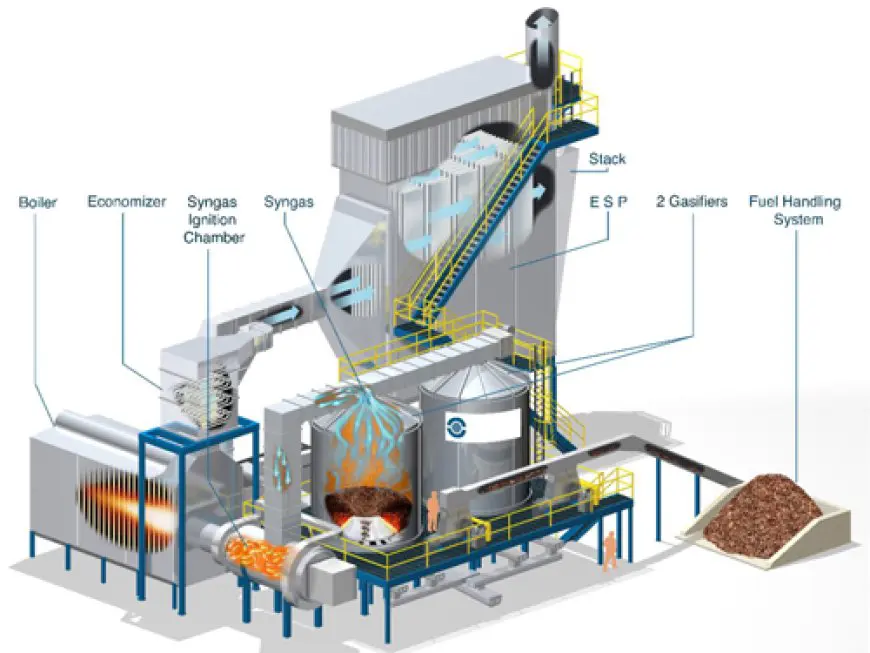Biomass Power Generation Market Size & Share | Growth Analysis 2035
The biomass power generation market is expanding rapidly as industries seek more sustainable and eco-friendly energy solutions. Learn about the growth drivers, market trends, and investment opportunities in this promising sector.

The global Biomass Power Generation Market is indeed experiencing notable growth, with a projected increase in value from USD 90.9 billion in 2023 to USD 119.75 billion by 2032. This represents a Compound Annual Growth Rate (CAGR) of 3.1% between 2024 and 2032.
The Biomass Power Generation Market refers to the process of generating electricity from organic materials such as wood, agricultural residues, and other forms of biodegradable waste. Biomass power plants convert these materials into energy by burning them, fermenting them, or using other innovative technologies to produce clean, renewable energy. This sector has gained significant traction over the past decade due to the increasing demand for renewable energy sources and the growing concerns about the environmental impact of fossil fuels. Driving factors for the biomass power generation market include the rise in government initiatives for clean energy, growing awareness of climate change, and the need for sustainable waste management practices. Additionally, biomass power generation is considered carbon-neutral, making it an attractive option for countries striving to meet emissions reduction targets.
Get Access to A Sample Report with List of TOC, Charts, Figures @ https://www.vantagemarketresearch.com/biomass-power-generation-market-0779/request-sample
Market Dynamics
The market dynamics of the biomass power generation industry are shaped by various economic, technological, and environmental factors. The rapid increase in global energy demand, combined with the need for sustainable and low-carbon energy alternatives, has made biomass power generation a viable option for many countries. Increasing government regulations, including mandates and financial incentives, to curb greenhouse gas emissions and reduce reliance on fossil fuels, continue to drive the demand for biomass power plants.
One of the key drivers for the market is the rising focus on clean and renewable energy sources. Governments and private sector investments are accelerating the development of biomass infrastructure, further boosting market growth. The shift from conventional energy sources such as coal to bioenergy is becoming more pronounced, as biomass is seen as an effective way to meet renewable energy targets while managing waste.
Furthermore, technological advancements in biomass conversion technologies, such as gasification and anaerobic digestion, are playing a crucial role in enhancing the efficiency and scalability of biomass power plants. However, the market also faces several challenges, such as high initial investment costs, limited availability of raw materials, and competition from other renewable energy sources. Despite these hurdles, the increasing adoption of biomass power generation is expected to sustain its growth trajectory over the coming years.
Competitive Landscape
- ABB
- Siemens
- General Electric
- Prysmian Group
- Nexans
- Mitsubishi Heavy Industries Ltd.
- Suez
- Ramboll Group A/S
- Orsted A/S
- Ameresco
- Veolia
- Vattenfall
- Schneider Electric
Don’t miss out on this exclusive opportunity, enjoy a 25-35% discount @ https://www.vantagemarketresearch.com/buy-now/biomass-power-generation-market-0779/0
Top Trends in Biomass Power Generation Market
Several trends are shaping the future of the biomass power generation market. The first significant trend is the rise of advanced conversion technologies. Innovations in biomass gasification, torrefaction, and pyrolysis are enabling more efficient conversion of biomass into usable energy. These technologies allow for cleaner and more efficient energy production, minimizing waste and emissions.
Another key trend is the growing interest in decentralized energy production. Small-scale, distributed biomass power plants are becoming increasingly popular, as they can provide energy to local communities and industries while reducing transmission losses and increasing energy security. This trend is particularly relevant for rural and remote areas, where traditional energy infrastructure may be limited or unavailable.
The integration of biomass power generation with other renewable energy sources, such as solar and wind, is another prominent trend. Hybrid systems that combine biomass with solar or wind power are gaining traction due to their ability to provide a more stable and reliable energy supply. These hybrid systems offer greater efficiency and can help mitigate the intermittent nature of solar and wind energy.
Moreover, biomass power generation is aligning with the concept of a circular economy. By utilizing waste materials, such as agricultural residue and municipal solid waste, for energy production, biomass power plants contribute to waste reduction and promote sustainability. This trend is driving the expansion of waste-to-energy technologies and is expected to contribute significantly to the growth of the biomass power generation market.
Segmentation Insights:
By Feedstock
- Agriculture Waste
- Forest Waste
- Animal Waste
- Municipal Waste
By Technology
- Combustion
- Gasification
- Anaerobic Digestion
- Pyrolysis
By Fuel
- Solid Fuel
- Liquid Fuel
- Gaseous Fuel
Purchase This Premium Report Now @ https://www.vantagemarketresearch.com/buy-now/biomass-power-generation-market-0779/0
Challenges
Despite its promising growth, the biomass power generation market faces several challenges that could hinder its expansion. One of the primary obstacles is the high capital investment required to set up biomass power plants. The cost of building and maintaining biomass facilities, along with the associated infrastructure, can be prohibitively expensive for some countries or companies, particularly in emerging markets.
Another challenge is the availability and supply of raw materials. Biomass power generation depends heavily on the availability of organic materials such as wood chips, agricultural residues, and even waste from forestry operations. The increasing demand for these materials can lead to supply shortages, which could push up prices and make it harder for power plants to secure consistent feedstock.
Additionally, the efficiency of biomass power generation is still lower compared to other renewable sources like wind and solar energy. While technologies are improving, biomass conversion processes remain more complex and less efficient than more established renewable technologies. This inefficiency can increase operational costs and limit the economic viability of biomass power generation in some regions.
Lastly, competition from other renewable energy sources, such as wind, solar, and hydropower, can present a challenge for biomass power generation. As the cost of solar and wind energy continues to decrease, biomass may struggle to compete unless it can offer cost-effective solutions or new technologies that make it more competitive.
Opportunities
The biomass power generation market holds significant potential for growth, primarily due to its ability to provide a sustainable and renewable source of energy. One of the key opportunities lies in the increasing push towards cleaner energy. As governments around the world set ambitious carbon reduction targets, biomass power generation offers a means to reduce emissions and meet these goals while promoting energy security.
Another opportunity lies in the untapped potential of waste-to-energy technologies. Biomass power plants can use waste materials from agriculture, forestry, and even municipal waste, converting them into energy and helping to reduce landfill waste. This opportunity is particularly relevant in developing countries with abundant waste resources but limited energy infrastructure.
The integration of biomass with other renewable energy sources also presents an exciting opportunity for the market. By combining biomass with solar, wind, or hydropower systems, the energy generation process can become more reliable and efficient, ensuring consistent energy production. This trend could drive the adoption of hybrid systems, leading to further growth in the biomass power generation market.
Furthermore, advancements in technology, such as improved biomass conversion processes and the development of more efficient biofuels, present significant opportunities for market players to enhance the performance of their power plants and reduce operational costs.
Read Full Research Report Here @ https://www.vantagemarketresearch.com/industry-report/biomass-power-generation-market-0779
Key Questions Answered in the Biomass Power Generation Market Report
- What are the current market trends influencing biomass power generation?
- How does the demand for renewable energy impact the biomass power generation market?
- What are the key drivers and restraints affecting the growth of the biomass power generation market?
- What technological advancements are contributing to the efficiency of biomass power plants?
- How does biomass power generation compare to other renewable energy sources like wind and solar?
- What are the economic challenges and opportunities in biomass power generation?
- How do government policies and incentives influence the biomass power generation market?
- What are the key regional markets for biomass power generation, and how do they differ in terms of growth prospects?
Regional Analysis:
North America is one of the key regions contributing to the growth of the biomass power generation market. The United States, in particular, has a well-established biomass industry, driven by the need to meet renewable energy targets and reduce greenhouse gas emissions. With policies such as the Renewable Energy Standards (RES) and federal tax credits, the region has seen significant investments in biomass power plants, especially in rural and agricultural regions where feedstock is abundant.
Canada also plays a vital role in the North American biomass market, with a focus on converting forest waste into energy. The country has vast forest resources, and utilizing this biomass feedstock for energy production has been a priority for the government. This approach not only contributes to reducing emissions but also promotes sustainable forestry practices.
Both the U.S. and Canada are expanding their biomass energy production, with a growing emphasis on waste-to-energy technologies and the development of advanced biomass conversion methods. As the demand for renewable energy continues to rise, North America is expected to remain a leading region for biomass power generation, with continued investments in infrastructure and technology.













![Dialysis Market Size, Share, Trends | Growth Analysis [2035]](https://www.marketbusinessinsights.com/uploads/images/202502/image_140x98_67b34ae16c42c.webp)



